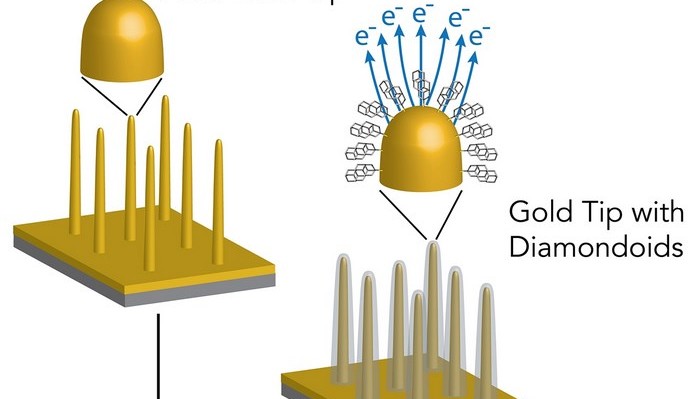Diamond layer boosts electron flow 13,000x
December 23, 2015
on
on

The term “electron gun” may conjure up images of sci-fi weapons, but in fact electron guns are used in a wide variety of peaceful applications such as electron microscopes, semiconductor fabrication and particle accelerators. Researchers at Stanford University and the SLAC National Accelerator Laboratory have now discovered a way to boost the electron flow by applying a nanolayer of diamondoids to the tip of the electron gun.
Diamondoids are very small cage structures of carbon and hydrogen atoms that form the smallest possible elements of diamonds. A diamondoid weighs only one billionth of a carat. Thanks to their tiny dimensions, very strong structure and extreme chemical purity, diamondoids have interesting properties that are missing in true diamonds.
In an electron gun the output capacity can be increased by making the tip as sharp as possible so it is easier for electrons to leave the metal at the tip. However, a very sharp tip is usually fairly unstable, and even the tiniest irregularity affects the electron flow. In this study the researchers carried out experiments with nanorods made from germanium wire as stand-ins for the tip of an electron gun. The rods were plated with a thin layer of gold, followed by diamondoids of various sizes. The effect was the strongest on tips with a diamondoid consisting of four cages: the number of emitted electrons was 13,000 times as large as with a bare gold tip.
Illustration: Karthik Narasimha / Stanford
Diamondoids are very small cage structures of carbon and hydrogen atoms that form the smallest possible elements of diamonds. A diamondoid weighs only one billionth of a carat. Thanks to their tiny dimensions, very strong structure and extreme chemical purity, diamondoids have interesting properties that are missing in true diamonds.
In an electron gun the output capacity can be increased by making the tip as sharp as possible so it is easier for electrons to leave the metal at the tip. However, a very sharp tip is usually fairly unstable, and even the tiniest irregularity affects the electron flow. In this study the researchers carried out experiments with nanorods made from germanium wire as stand-ins for the tip of an electron gun. The rods were plated with a thin layer of gold, followed by diamondoids of various sizes. The effect was the strongest on tips with a diamondoid consisting of four cages: the number of emitted electrons was 13,000 times as large as with a bare gold tip.
Illustration: Karthik Narasimha / Stanford
Read full article
Hide full article


Discussion (0 comments)